
The Wood Shop: What We Talk About, When We Talk About Plus-Minus
2016-05-06
When I think of a wood shop, I think of a place people go to contemplate things. Wood working happens in them for sure, but it’s really just a convenient hobby. It takes a long time to complete even a small piece of wood work, which means many trips to the shop to really examine the intricacies of life. This article is part of a continuing series where I take some aspect of this Cavalier team into the wood shop and hang out with it for a thousand or so words. My own personal Cavs Wood Shop.
Lineup data is illuminating to say the least. Let’s look at the Cavs’ best five man unit according to plus-minus. During the regular season, it was LeBron James, Kyrie Irving, Kevin Love, Iman Shumpert, and Tristan Thompson. They outscored opponents by 26.8 per 48 minutes. What’s that really mean though?
That number is pretty ridiculous for a few reasons. First off, and most obviously, a unit can’t play 48 minutes. The reason the number is converted into a 48 minute rate is just so some comparisons can be done. If a group plays six minutes a game and another group plays 14 minutes, comparing their straight plus-minus per game is going to be a little misleading. Secondly, outscoring guys by 26.8 over the course of the game puts this unit in the top ten for the league.
The Warriors make that number look childish though. Their regular season death lineup made up of Stephen Curry, Draymond Green, Harrison Barnes, Andre Igoudola, and Klay Thompson was beastly. They had an average plus-minus of 4.5 a game. Over 48 minutes, that unit would have outscored opponents by 46.3 points. That’s number one in the whole league for a 48 minute plus-minus rate.
The Process of Comparing 5-man Groups
Comparing the Cavs’ unit and the Warriors’ unit is a really simple thing to do, and it’s actually not all that productive if you’re trying to learn more about what works for a team. Think about this question for a second in the context of a five man unit’s plus-minus per 48: What if the Cavs cloned LeBron and had a team of just him? If that group had the same plus-minus as the group I mentioned above, you would be disappointed. After all, LeBron is better than Shumpert, and Irving at their respective positions. Units need to be looked at as a product of what’s making them up.

To truly understand what Cavalier groupings work best, it’s helpful to compare the reality of a unit to the statistical vacuum stats that a unit should produce. To do that you first adjust the plus-minus ratings of players on a team to a per 48 minute rate (any rate works, this is just what I decided to use). Once that is done, you can take any lineup you find and figure out how effective it is. For each five man group, you set their plus-minus to a rate. Then you have to do a little more math. You take the players that make up a groupings’ per 48 plus-minus, add their plus-minus/48 together, and then divide by five to find out what their average plus-minus/48 is (EXPECTED PM/48=(Player1’s PM/48 + P2PM/48+P3PM/48+P4/PM48+P5PM/48)/5). That number is what makes up a groupings’ expected plus-minus. Finally, you take the actual plus-minus and subtract the expected plus-minus. If the number is positive, then a unit is performing better than expected. If it’s negative, then the unit is under performing.
Look at this chart for the regular season.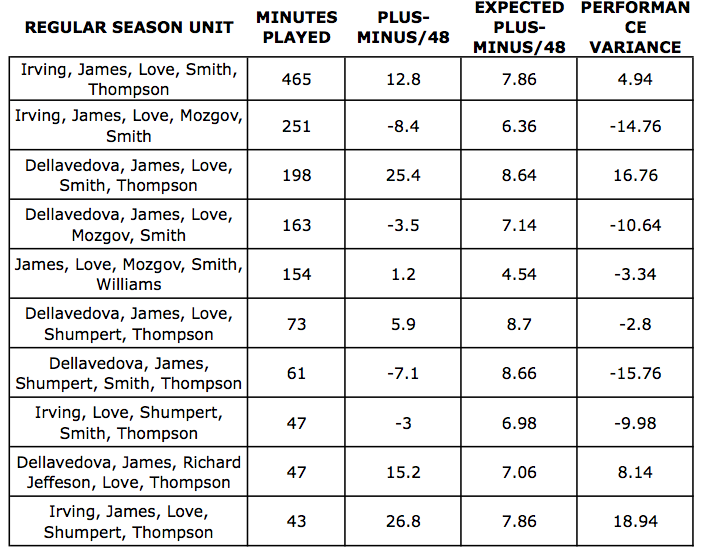
Under Performers: Mozgov and Shump
This chart has the top ten most used units for the Cavaliers. Six of them were actually under performing and four were beating their projections. The units that weren’t cutting it are hard to compare. Three of them featured Timofey Mozgov. That’s not very surprising. Mozzy had trouble this season averaging just 6.3 points and 4.4 rebounds. Both of those numbers are less than last year. He has pretty much been out of the rotation so far in the the playoffs. Swapping Mozgov for Thompson in the grouping with Love, Smith, James, and Irving resulted in a 19.7 point swing. Sorry Mozgov, your hands of steel are only super hero esque off the court.
The other two poorly performing units feature Shumpert. Shumpert has had sort of a down year too. He came back late after injuring his hand, and he shot 37% from 3-point land after going 41% last season. He also gets very excited to dribble just four feet inside of the arc and launch a long two. When Shumpert was with Smith, Thompson, James, and Delly, that group was supposed to score 8.66/48. Instead, they put up -7.1. What’s even worse is the fact that a swap of Shumpert for Love in that situation, resulted in the lineup that put up 16.76 more points than expected. That’s a 23.86 point swing.
What’s weird about Shump though is that he is in the unit that beat expectations the most for Cleveland: Irving, James, Love, Shumpert, and Thompson. They were nearly 19 points better than they should have been during the regular season. The only reason I can think of for why Shump didn’t sink that group was because he never got the ball. Irving, James, and Love probably passed him the ball only for open shots or when absolutely necessary. He defended and kept the corners warm while thinking about new rap lyrics.
The Regular Season’s Real Big Three
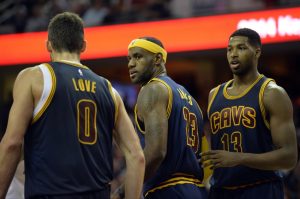
Mandatory Credit: David Richard-USA TODAY Sports
The best groupings during the regular season had three things in common: Love, James, and TT. Those three appear in every single lineup that had a positive performance. It’s interesting to note that playing Delly instead of Irving with Love, Thompson, Smith, and James resulted in the group being 11.82 points per 48 better. The actual plus-minus was 12.6 more.
Playoffs Mean Small-Ball
Take a look at the chart for expected vs. actual plus-minus for the playoffs so far.
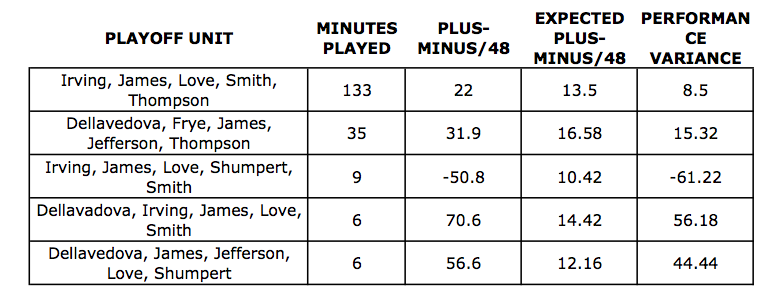
Four of the five most used units are performing at absurd levels. Delly, Irving, James, Love and Smith have an actual plus-minus of 70.6 per 48, and that’s 56.18 better than it should be. What really interests me though is Cleveland’s transition to small-ball, the King at the four. James is playing power-forward in Cleveland’s two best lineups.
During the regular season, the only top ten used unit where James played at the four was a failure. James, Smith, Delly, Thompson, and Shumpert had an actual pm/48 of -7.1.
The reason the Cavs are successfully placing James at the four now is because of what I deem the rule of one. Any Cavs unit with James at the four needs to have four guys who can shoot the 3-ball. If you have more than one guy who can’t, teams can manage a double (with a third guy shading over to him) on LeBron and actually move a small forward or wing player onto him without worrying about a bigger guy having to cover a shooting threat around the 3-point line. The King can pass out of a double team, but when three guys are locking onto to him, he’s going to have a little bit of trouble.
It’s telling that the Cavs grouping of Delly, Irving, Smith, Love, and James is the best so far in the playoffs exceeding expectations by 56.18 points per 48. James just needs to drive and can then kick out to one of four shooters. Or, he can cut off the ball as teams worry about someone getting an open deep shot or drive to the basket.
The grouping of Love, Shump, Smith, James, and Irving doesn’t violate the rule of one, despite being under expectations by 61.22 points. Since the sample size for the playoff lineups is quite small, I can only surmise that this group was on the floor during a few major runs by the opponent.
The Pecking Order
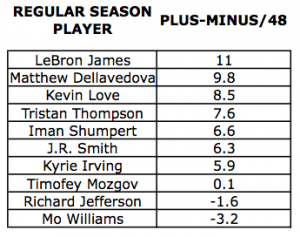
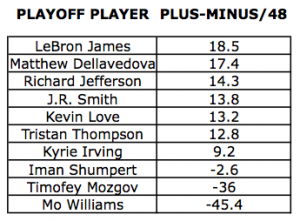
Those two charts show the plus-minus/48 for the individual Cavaliers during the regular season and during the playoffs. Almost every guy has revved up their performances, aside from Shump, Williams, and Mozgov. Jefferson has had the biggest swing of any Cavalier going up by 12.6 points/48. The vet knows what’s needed.
During the year, many of us on the blog have joked that Delly is better than Kyrie, or a least a better fit. These stats continue to confirm that view point. It’s not a fluke that Delly maintains second place, as far as plus-minus goes, even in the playoffs. In the regular season he averaged 7.5 points and shot 40% from deep. During the playoffs, he has averaged seven points and is 43.8% from 3-land. He’s dishing the ball 4.3 times a game and turning it over just .3 times a game. Those numbers are not super-star numbers. His ability to be in second on the team for plus-minus/48 is a testament to all of the little things he does on the court that improve the whole team.
A Work in Progress
After pouring through all of the lineup information, playoff and regular season, I thought I would have a solid observation about what Cavalier lineups work best. However, the successful regular season and playoff lineups are quite different. In the regular season, the Irving, James, Love, Shumpert, and Thompson group was the best unit getting 26.8 points per 48 more than opponents. In the postseason, James, Love, Delly, Smith, and Irving have been beating the world up by a margin of 70.6 points per 48.
About a week ago, I wrote about LeBron’s return to dominance. It was all about him changing how he plays towards the end of the season. Right now, he is working off the ball more, holding the ball less, and filling in the gaps for the team. This team is still adapting to the King’s changes, and the lack of one dominant regular season and playoff lineup shows that.
*All stats from nba.com



Good work. You’re missing Frye’s +/- per 48 on the last two charts. Also really surprised you skipped Offensive and Defensive RPM, or really any discussion of RPM at all.
You have to think the Cavs staff has all of these stats, and look at them. I think the likeliest explanation as to why they’ve ignored some of this data is that they are saving lineups for deep in the playoffs. We’re seeing some of the game plans already with the increased three shooting. We may see more Kyrie/Bron p n’ r next series. What do you think Mr. Wood?
I left Frye off because his numbers just seemed so out there. Although, after last night they might be a bit more valid than I thought. I love RAPM but that warrants a piece to itself. Cavs are still hiding their true intentions for sure, but 3s are what is going to drive them offensively. The question is whether or not they can stay hot. I hope JR fizzles next series and that it goes long. We need hot man for the Finals. I like the Kyrie Bron pick and roll however both are better trying tnabuse a one on… Read more »
Awesome stuff DW! It’s really interesting to see the variance with the Shump lineups…
Good work! I was surprised Kyrie wasn’t a little higher individually in the playoffs now he has more mins. Regardless, all the number look good. We just need some more from Shump & Delly for offense. Much of that does have to do with the lack of mins.